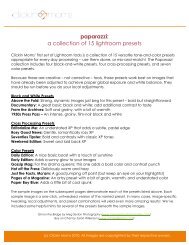Here - Clickin Moms
Here - Clickin Moms
Here - Clickin Moms
You also want an ePaper? Increase the reach of your titles
YUMPU automatically turns print PDFs into web optimized ePapers that Google loves.
When<br />
I<br />
affected setting exposure actually hurt my brain. My first<br />
got my speedlite all I knew was that it went on top of my<br />
camera and that I could now bounce my flash. I had no<br />
idea which mode to put it in and thinking about how it<br />
few test shots were completely blown so I blindly fiddled with the settings until I got the<br />
exposure right. Then I bounced it off of every surface and angle imaginable. Once in<br />
a while I would luck out and get a shot that I thought looked like it should, but there was<br />
no rhyme or reason to it. I’m usually good at figuring out how things work, but flash was a<br />
mystery to me and I gave up on it pretty quickly and deemed myself a photographer who<br />
“shoots exclusively with natural light.” Sound familiar<br />
One of my resolutions for 2010 was to master<br />
my flash. While I’m far from that lofty goal,<br />
I did make a lot of progress. Using flash no<br />
longer terrifies me and I would even say that<br />
I am very comfortable with it. Getting to this<br />
point involved a lot of head banging, talking<br />
to myself, countless hours of learning by trial<br />
and error and more a-ha moments than I<br />
can count. <strong>Here</strong> are a few things that I wish<br />
I’d known when I took my speedlite out of<br />
the box for the first time.<br />
Put your camera in manual and your<br />
flash in TTL.<br />
While it’s true that manual flash is more<br />
consistent than TTL, it’s not practical for<br />
on-camera flash and situations where the<br />
photographer and subject are moving.<br />
Manual flash gives off a set amount of light<br />
each time it’s fired. That means, if you move<br />
closer or farther away from your subject and<br />
don’t change your settings, your shot will be<br />
over or underexposed.<br />
In TTL mode, your camera’s metering system<br />
measures the reflectivity and average<br />
tonal values of a scene and determines<br />
the amount of flash needed to produce a<br />
correct exposure. However, because it is<br />
exposing for average tones, the exposure<br />
will not always be perfect. It should be close<br />
though and flash exposure compensation<br />
(FEC) allows you to tweak it until it’s perfect.<br />
The rules for manual flash and TTL<br />
flash are different<br />
With manual flash, aperture controls the<br />
exposure of the area being lit by the flash<br />
and shutter speed controls the ambient light<br />
exposure of the background. With TTL flash,<br />
you are not limited to using shutter speed to<br />
control the amount of ambient light in the<br />
exposure. Aperture, ISO and shutter speed<br />
can all be used control ambient light. This<br />
creates endless possibilities and gives you<br />
almost complete control over the way the<br />
ambient light appears in your image.<br />
Your camera settings do matter.<br />
I discovered pretty quickly that with TTL<br />
flash and FEC, you can pick any camera<br />
settings (as long as you stay under the<br />
maximum shutter sync speed) and get a<br />
properly exposed photo. Unfortunately,<br />
when using flash, properly exposed photos<br />
are not necessarily good photos. A good<br />
rule of thumb is to meter for the location, use<br />
FEC to set flash exposure and then change<br />
the camera settings to underexpose the<br />
background a stop or two. This will separate<br />
your subject from the background and make<br />
your photo pop.<br />
Bounced flash is not the secret to good<br />
flash photography.<br />
51






